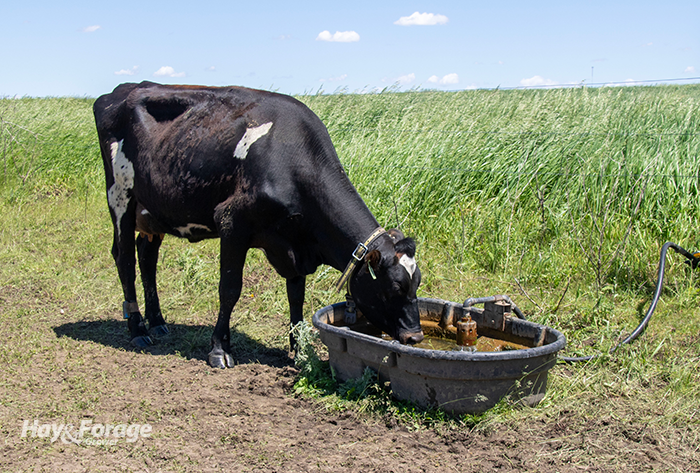
Natural water sources in pastures are only as valuable to a grazing system as the quality of water they contain. In other words, the health and performance of livestock will suffer if animals are subject to contaminated water, especially if that water is fraught with blue-green algae.
In a recent Beef Tips newsletter from Kansas State University Extension, AJ Tarpoff says the combination of sunny, hot, and dry conditions create an ideal environment for blue-green algal blooms to thrive in pasture ponds; however, the sporadic occurrence of these blooms makes it hard to prevent contamination. To be sure, the extension veterinarian adds that blue-green algal blooms are not even made up of algae — they are accumulations of cyanobacteria.
Tarpoff explains that some species of cyanobacteria can produce and release neurotoxins and hepatotoxins. Neurotoxins can severely damage animals’ nervous systems, and unfortunately, the first indication of consumption is usually dead cattle. With that said, early signs of infection include muscle tremors, difficulty breathing, seizures, slobbering, and diarrhea.
Hepatotoxins, on the other hand, can cause liver failure. Affected animals can experience weight loss and photosensitization, which looks like severe sunburn on hairless areas of the body. In any case, he cautions that there are no known antidotes for the effects of cyanotoxin. Therefore, scouting for blue-green algal blooms is critical.
Paint-like appearance
According to Tarpoff, blue-green algal blooms float at or just below the water surface, giving the appearance of paint in the water. They turn blue-green — or red or brown — when cyanobacteria die. Although toxin concentrations in individual blooms can vary, he warns that accumulations of blooms near pond edges and shorelines can be much more lethal.
“Since blooms can establish quickly, monitor ponds closely and be prepared to sample pond water if the green paint-like consistency is observed or if acute animal deaths are found in the pastures,” Tarpoff states. “The water sample itself is a snapshot in time, so proper handling and methods of obtaining the sample will help deliver accurate results.” He offers the following sampling tips.
• Take samples of blooms from just below the water surface. “Remember, it will have the appearance of blue or green paint floating in the water, not floating mats of moss or aquatic vegetation,” Tarpoff states.
• Collect at least 500 milliliters (roughly 2 cups) of water that includes fragments of the paint-like scum.
• Do not touch the bloom — it can cause skin irritation.
• Immediately cool samples in a refrigerator, then send chilled samples on ice to a diagnostic lab.
Despite being the most expensive option, Tarpoff says fencing off natural water sources and installing alternative waterers is the best solution to avoid contamination. Farmers can also opt to only fence off certain areas of natural water sources, like downwind portions of ponds where algal blooms can accumulate.
“Improved watering areas, such as pipe-fed waterers, may also limit exposure, as long as the water inlet is located in a low-risk area of the pond,” Tarpoff writes. “A submerged inlet in the center of the pond is an area where cyanobacteria are unlikely to concentrate.”
Tarpoff adds that controlled access to natural water sources and tank waterers can improve other aspects of water quality by reducing sediment and nutrient buildup and preventing coliform bacteria accumulation.

